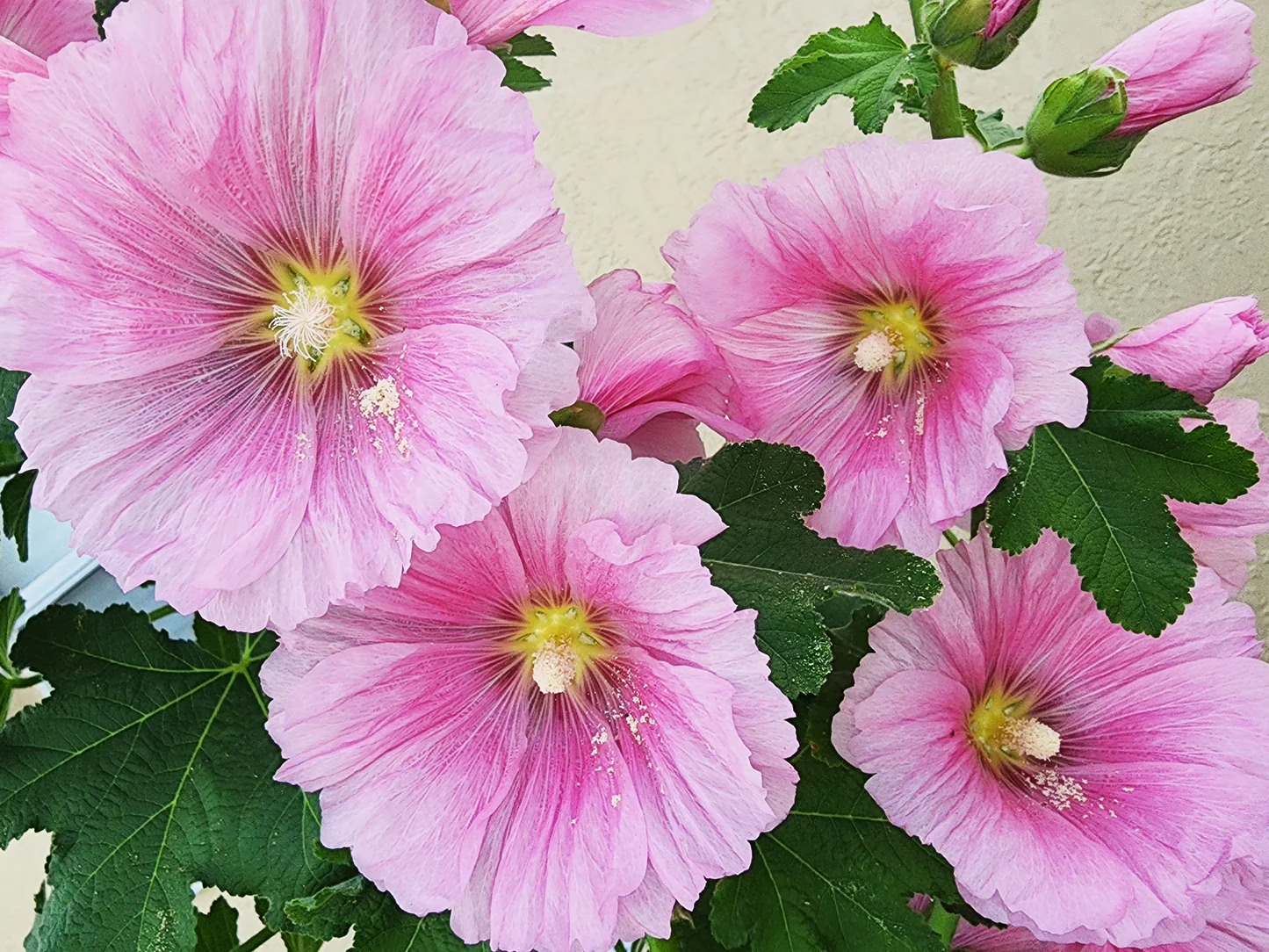
Hollyhocks
Botanical Name
:
Alcea rosea
Plant Type
:
Herbaceous biennial
Seasons
:
Summer (blooms in the second year)
Sun Level
:
6–8 hours of full sun daily
Ideal Soil Temperature for Planting
:
60–70°F (15–21°C)
Soil Type
:
Well-draining, fertile soil
Germination
:
10–14 days at 60–70°F (15–21°C)
P.H. Level
:
Neutral to slightly alkaline (6.5–7.5)
Water/Irrigation
:
Keep soil moist but not waterlogged and water regularly in dry seasons.
Fertilization
:
Light feeding in spring with compost or a balanced organic fertilizer.
Habit
:
Tall, upright, single-stemmed (though branching can occur), with large, rounded leaves.
Final Plant Height
:
60–96 inches (150–240 cm)
Spread
:
18–24 inches (45–60 cm)
Spacing
:
18–24 inches apart (45–60 cm)
Flowers
:
Large, showy, funnel-shaped flowers in shades of pink, red, yellow, white, or purple. They bloom in succession up the stalk.
Attracts
:
Bees, butterflies, and hummingbirds
Uses
:
Cottage gardens, borders, back of flower beds, and cut flowers
Companions
:
Delphiniums, Foxgloves, clematis, Canna lilies
Pruning
:
Deadhead spent flowers to encourage prolonged blooming and cut back after flowering to maintain tidiness
Toxicity
:
Non-toxic to humans and pets
Pests
:
Aphids, spider mites, and Japanese beetles
Diseases
:
Rust, powdery mildew, and leaf spot (if conditions are too humid)
Additional Info
:
Hollyhocks are susceptible to rust so ensure good air circulation and avoid overhead watering. In colder climates, mulch around the base in winter to protect roots from freezing.
Did You Know?
Hollyhocks flowers are edible and add color to salads or as a garnish.
Botanical Name
:
Alcea rosea
Plant Type
:
Herbaceous biennial
Seasons
:
Summer (blooms in the second year)
Sun Level
:
6–8 hours of full sun daily
Ideal Soil Temperature for Planting
:
60–70°F (15–21°C)
Soil Type
:
Well-draining, fertile soil
Germination
:
10–14 days at 60–70°F (15–21°C)
P.H. Level
:
Neutral to slightly alkaline (6.5–7.5)
Water/Irrigation
:
Keep soil moist but not waterlogged and water regularly in dry seasons.
Fertilization
:
Light feeding in spring with compost or a balanced organic fertilizer.
Habit
:
Tall, upright, single-stemmed (though branching can occur), with large, rounded leaves.
Final Plant Height
:
60–96 inches (150–240 cm)
Spread
:
18–24 inches (45–60 cm)
Spacing
:
18–24 inches apart (45–60 cm)
Flowers
:
Large, showy, funnel-shaped flowers in shades of pink, red, yellow, white, or purple. They bloom in succession up the stalk.
Attracts
:
Bees, butterflies, and hummingbirds
Uses
:
Cottage gardens, borders, back of flower beds, and cut flowers
Companions
:
Delphiniums, Foxgloves, clematis, Canna lilies
Pruning
:
Deadhead spent flowers to encourage prolonged blooming and cut back after flowering to maintain tidiness
Toxicity
:
Non-toxic to humans and pets
Pests
:
Aphids, spider mites, and Japanese beetles
Diseases
:
Rust, powdery mildew, and leaf spot (if conditions are too humid)
Additional Info
:
Hollyhocks are susceptible to rust so ensure good air circulation and avoid overhead watering. In colder climates, mulch around the base in winter to protect roots from freezing.
Did You Know?
Hollyhocks flowers are edible and add color to salads or as a garnish.

